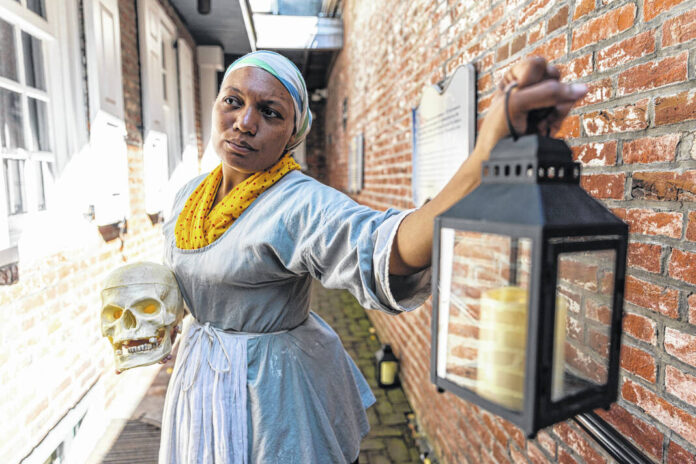PHILADELPHIA — Halloween tales told at the Betsy Ross House have nothing to do with flag making — or even ghosts. There are no cheap scares amid the lantern light — no colonial-costumed ghouls emerge in the courtyard fog or surprise in the shadows of creaky rooms.
Instead, the frights to be had after dark at the famed flag maker’s former Old City digs and upholstery shop come from something far scarier: the truth. Chilling stories from Ross’ own hard life and times.
A frighteningly familiar fever that wiped out 10% of Philadelphia, including Ross’ parents and sister only days apart. The medical horrors of an age when diseases such as smallpox and yellow fever claimed countless lives — and treatments such as bloodletting were still used for the common cold, and brain surgeries and amputations were performed without anesthesia. A time when personal hygiene was so poor that even people much wealthier than Ross could go almost their whole life without a bath.
“The true stories — the ones that are based in historical facts and have primary source documents to back up — those are the ones we tell,” said Lisa Acker Moulder, director of the Betsy Ross House, which is managed by Historic Philadelphia. “And they are the scarier, because you can’t dispute them.”
Called the Spooky Twilight Tours — and running Friday and Saturday nights through Halloween — they promise a trip back into 1700s Philadelphia and the city’s “gruesome history of infection and inoculation.” The idea, naturally, sprouted from the pandemic. By fall of 2020, with COVID-19 fears choking attendance — and school and tour groups staying home — the Betsy Ross House searched for ways to stay relevant and busy.
“We really struggled to get people through the doors,” Moulder said. “But we found that locals wanted something to do. So we created the evening tours for people who live in Philadelphia and the suburbs and just wanted to get out of the house. It was just a way to get bodies back into the Betsy Ross House.”
With most of the tour taking place in the courtyard — and only small groups allowed in the house at any time — the tours were a hit that first year, and grew only more successful. This year they added more dates.
But the tours were also part of a larger effort by the Betsy Ross House, which began before the pandemic to transform itself into a more engaging and critical historical hot spot. In recent years, tours and exhibits were altered to focus more on the more personal and relatable details of Ross’ life — her life as a single mother, her loss of three husbands, and financial hardships that left her relying on charity at times.
They also opened up the house for more community events. History-themed happy hours — and movie nights in the courtyard, with campy horror flicks and tours to lure locals who may otherwise skip the birthplace of America’s flag.
Overall, attendance has recovered to 80% of pre-pandemic levels, Moulder said.
“To keep a museum sustainable and relevant, you have to make sure you are appealing to your community,” Moulder said. “And that’s why we have created these kinds of events.”
And though the Halloween tours include some gross subject matter with little connection to Ross — including a tale about the amputation of a single leg that somehow led to the deaths of three men, which you need to hear the guides tell to believe — it never strays too far from the struggle and triumphs of Ross’ life. How nearly half of her 16 siblings died before adulthood. How she lost two of her own children from illness. How she was widowed — and eventually reburied — three times.
And the most important truth of it all: How Ross survived the horrors of an unforgiving life and made her flag.







